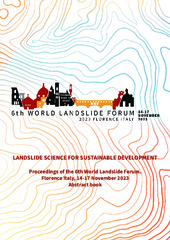Приказ основних података о документу
Upscaling and downscaling landslide susceptibility maps
| dc.contributor | Tofani, Veronica | |
| dc.contributor | Casagli, Nicola | |
| dc.creator | Marjanović, Miloš | |
| dc.creator | Sandić, Cvjetko | |
| dc.creator | Đurić, Uroš | |
| dc.creator | Abolmasov, Biljana | |
| dc.date.accessioned | 2023-12-27T12:23:48Z | |
| dc.date.available | 2023-12-27T12:23:48Z | |
| dc.date.issued | 2023 | |
| dc.identifier.isbn | 9791221048063 | |
| dc.identifier.uri | https://grafar.grf.bg.ac.rs/handle/123456789/3357 | |
| dc.description.abstract | Although without official standardization, landslide susceptibility models (LSM) have entered preliminary stages of design and planning practice worldwide. As design and planning itself undergoes from lower to higher level of detail, different scales of LSM apply. Nevertheless, the LSMs are mainly produced in regional scales, whereas national and local are rarely available. Limitations of downscaling and upscaling LSMs are considered herein, by comparing LSMs coming from continental scale on one hand, and regional scale on the other, while the validation was performed using national scale model (Figure 1) at 30 m pixel resolution. Pan- European model (Wilde et al. 2018) is downscaled from 200 to 30 m pixel resolution using re-gridding method based on various interpolation techniques (linear, spline, Kriging) over the area of the City of Doboj in Republic of Srpska (Bosnia and Herzegovina). The LSM for the City of Doboj (Sandić et al. 2023) was upscaled from 5 to 30 m resolution using various resampling techniques (nearest neighbor, bilinear interpolation and cubic convolution). All maps were made using heuristic or combined heuristic approaches with standard landslide conditioning factors as raster inputs (geological, geomorphological, environmental, etc.). The best performing downscaling option was spline interpolation, while cubic convolution gave the best match against the referent LSM for the upscaling. Other downscaling variants tend to pixelate the map at 30 m resolution, whereas upscaling was not that considerably affected by technique choice. For large scale urban planning and preliminary design it is important to avoid pixilation as much as possible and smoothen the susceptibility classes so they can be compared against various elements, such as road and railway network features (higher-order curves, bridges, tunnels) and urban fabric footprints (housing, industrial, infrastructure). Results indicate that downscaling can be misleading and should be avoided if there is time and resource to perform appropriate local or regional scale LSM. | sr |
| dc.language.iso | en | sr |
| dc.publisher | OIC S.r.l., Viale della Giovine Italia, 17, 50122 Firenze, Italy | sr |
| dc.rights | openAccess | sr |
| dc.rights.uri | https://creativecommons.org/licenses/by-nc-nd/4.0/ | |
| dc.source | 6th World Landslide Forum, Florence, Italy, 14-17 November 2023, Abstract book | sr |
| dc.subject | Scaling techniques | sr |
| dc.subject | Pixel resolution | sr |
| dc.subject | Interpolation techniques | sr |
| dc.subject | Landslide susceptibility models | sr |
| dc.title | Upscaling and downscaling landslide susceptibility maps | sr |
| dc.type | conferenceObject | sr |
| dc.rights.license | BY-NC-ND | sr |
| dc.rights.holder | International Consortium on Landslides | sr |
| dc.identifier.fulltext | http://grafar.grf.bg.ac.rs/bitstream/id/12563/bitstream_12563.pdf | |
| dc.identifier.rcub | https://hdl.handle.net/21.15107/rcub_grafar_3357 | |
| dc.type.version | publishedVersion | sr |

